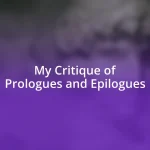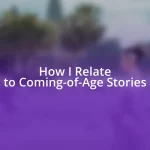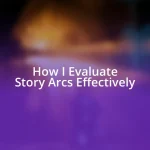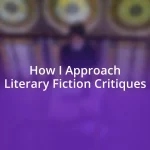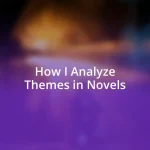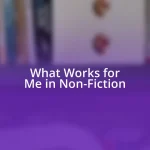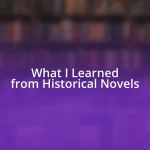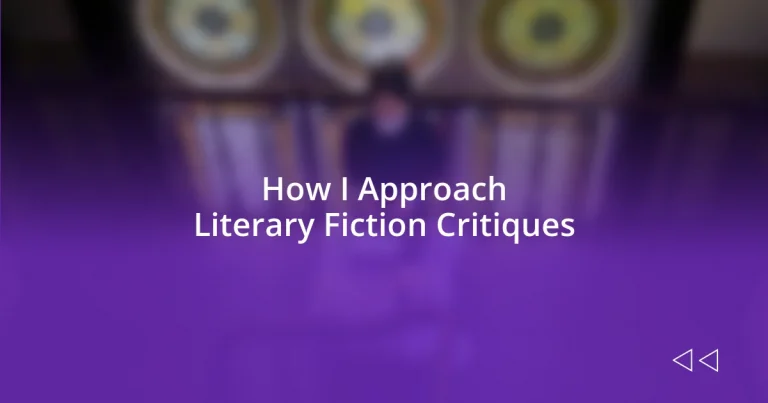Key takeaways:
- Contextual analysis enhances understanding by revealing the author’s motivations and contextual influences, enriching character development and thematic insights.
- Developing a critical reading habit fosters deeper engagement with literature through note-taking and discussion, transforming solitary reading into a community experience.
- Writing personal critiques involves freewriting initial impressions, analyzing specific narrative techniques, and connecting themes to personal experiences, enriching the overall understanding of the text.
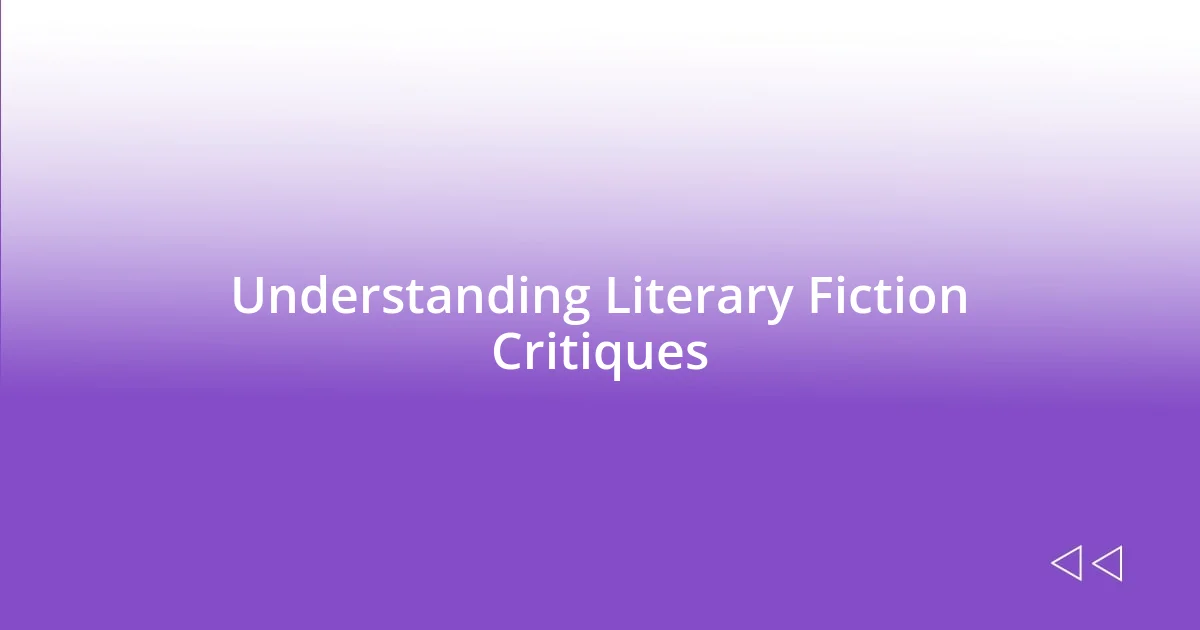
Understanding Literary Fiction Critiques
Understanding literary fiction critiques requires a nuanced approach, as they often delve into the author’s intentions and the broader themes woven into the narrative. I remember the first time I read a critique of Virginia Woolf’s “To the Lighthouse.” The critic’s insights opened my eyes to the intricacies of stream-of-consciousness writing and how it reflects deeper human emotions. Isn’t it fascinating how a well-crafted critique can reveal layers of meaning that we might overlook during a casual read?
When I engage with literary critiques, I often ask myself: what drives the author’s creative choices? This question enriches my understanding of the text and invites me to consider context—historical, cultural, or personal—that might influence the narrative. I recall feeling a surge of excitement when I discovered how Faulkner’s Southern upbringing shaped his complex characters and vivid settings, which later became a focal point in many critiques I encountered.
Moreover, literary critiques foster an appreciation for the craft itself. Analyzing the subtle symbolism or the unique narrative structure not only heightens my reading experience but also inspires me as a writer. I can’t help but wonder if other readers feel the same thrill when they connect the dots in a narrative that initially seemed bewildering. It’s that “aha” moment that keeps me coming back for more, and I believe it enriches our discussions about literature profoundly.
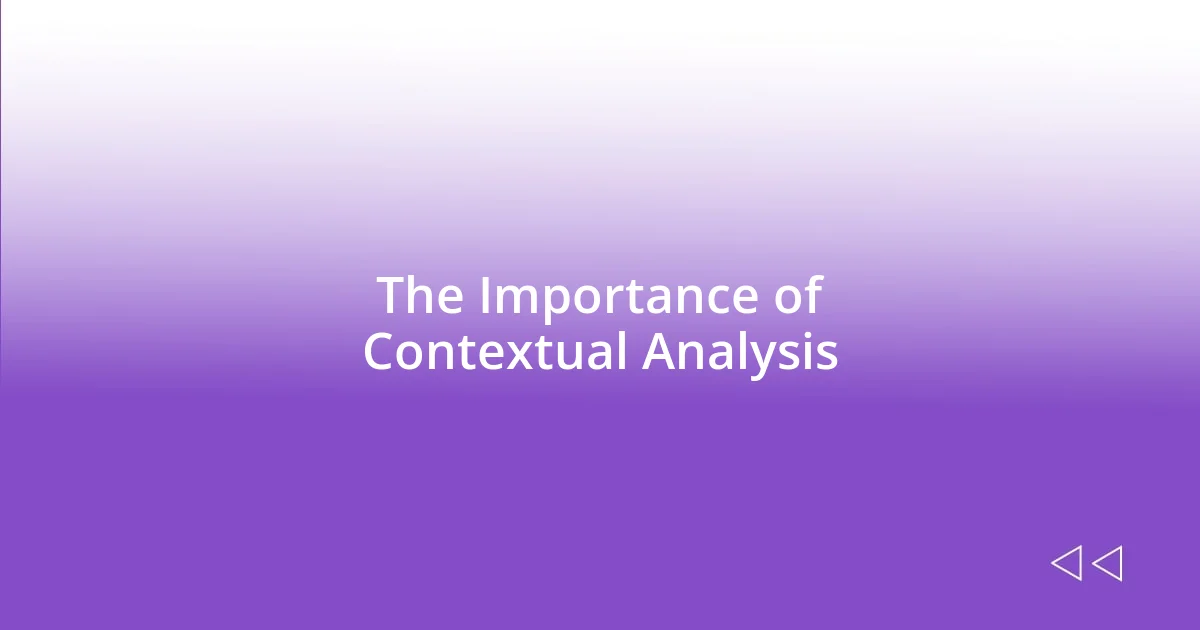
The Importance of Contextual Analysis
Contextual analysis is crucial when critiquing literary fiction because it enhances our understanding of a text, allowing us to see the myriad factors at play. I vividly recall reading a critique of Toni Morrison’s “Beloved,” which challenged me to explore the historical trauma of slavery and its lingering effects on identity. This perspective transformed my reading experience, revealing connections to themes of memory and loss that I had previously overlooked.
- It allows readers to grasp the author’s motivations and societal influences.
- Contextual analysis enriches character development by highlighting cultural backgrounds.
- It provides clues about the narrative style and thematic choices unique to the time period.
By embracing contextual analysis, I’ve learned to appreciate those subtle, yet powerful, nuances in literature that would have otherwise slipped past me. The joy of peeling back those layers feels akin to unearthing hidden treasures, igniting a deeper emotional connection to the story.
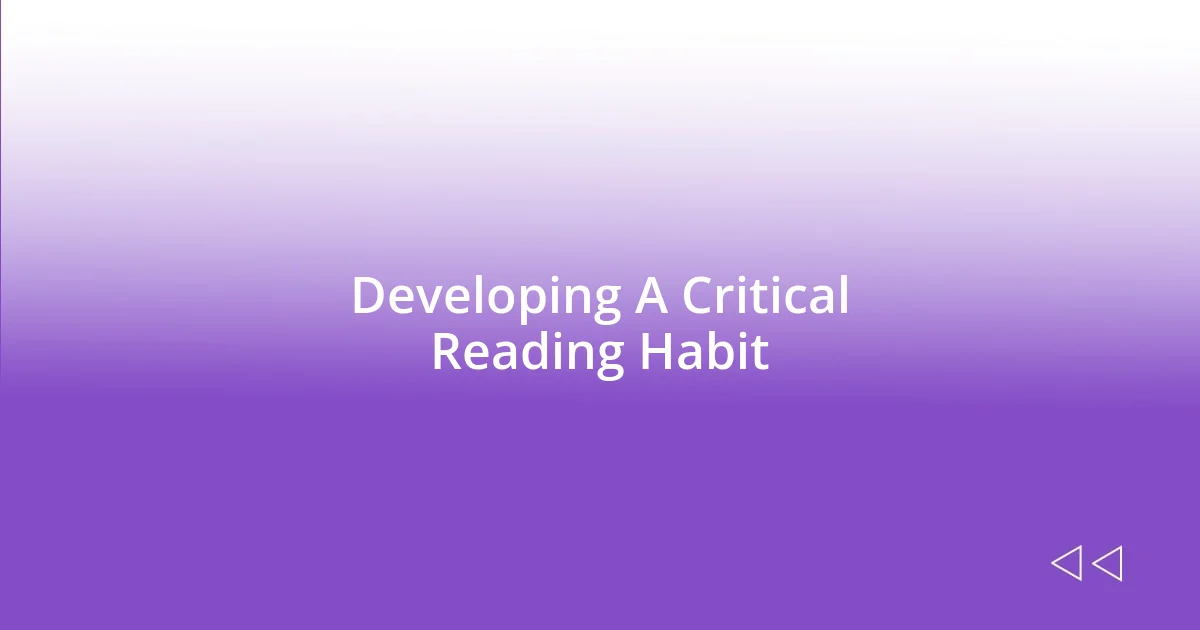
Developing A Critical Reading Habit
Developing a critical reading habit is a journey that transforms how we interact with literature. I remember the moment I decided to approach my reading with intention. Instead of simply savoring the plot, I took notes on characters’ motivations and thematic developments. This shift in mindset not only enhanced my understanding but also sparked deeper discussions with friends about the books we read together. Have you ever felt that rush of excitement after recognizing a theme that resonates with your own life?
As I cultivated this habit, I began to ask questions while reading, such as, “What is the significance of this setting?” or “How does this dialogue reflect societal norms?” This inquisitive approach enhances my engagement with a story, making it feel like an ongoing conversation between me and the text. I recall reading “The Great Gatsby” with fresh eyes, pondering why Fitzgerald chose that lavish, yet hollow, world to convey his critique of the American Dream. Each question peeled back another layer of meaning, making the reading experience more immersive.
I’ve also found that sharing insights with others builds a community of critical thinkers. Whether through a book club or online forums, discussing interpretations offers diverse perspectives that enrich my understanding. I recently joined a group focused on modern novels, where we dissected how contemporary issues are woven into narrative forms. These vibrant conversations have turned reading into a collective adventure, where each shared insight adds a new dimension to my reading experience.
| Activity | Purpose |
|---|---|
| Taking Notes | Helps engage with characters and themes |
| Asking Questions | Encourages deeper analysis and reflection |
| Discussion Groups | Offers diverse perspectives and insights |
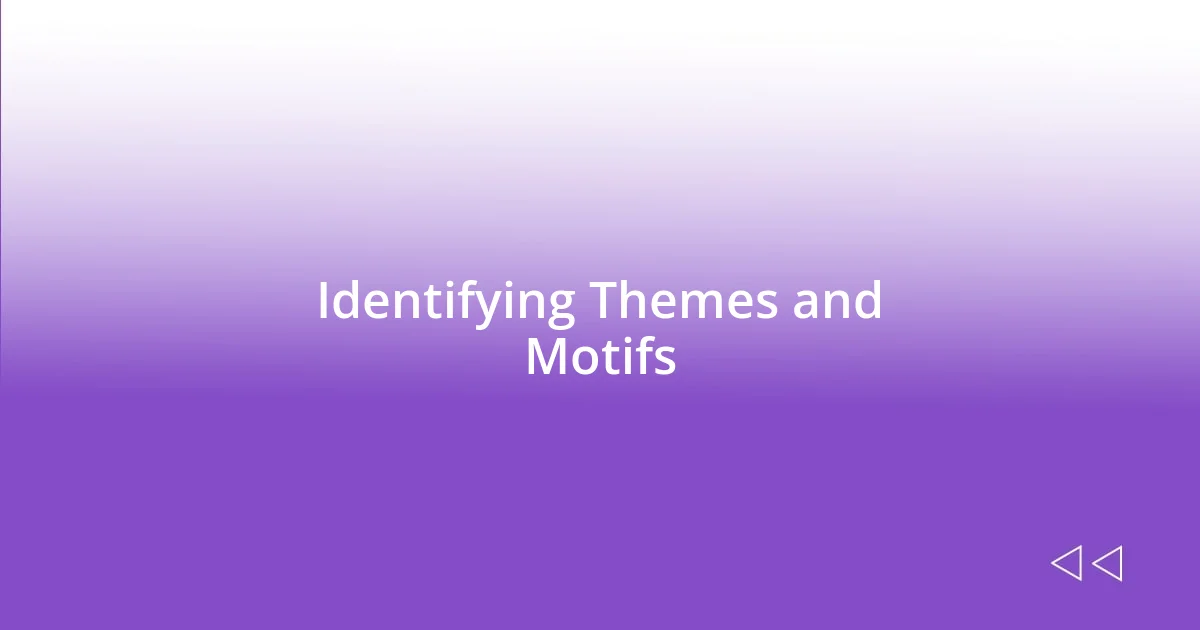
Identifying Themes and Motifs
Identifying themes and motifs in literary fiction is a bit like hunting for hidden gems. I remember reading “The Road” by Cormac McCarthy and being struck by the recurring motif of fire. It symbolizes hope, survival, and the flickering essence of humanity amidst desolation. Each time it appeared, I found myself reflecting on how powerful those symbolic elements were in illustrating the father-son relationship. Have you ever noticed how certain motifs can resonate with your own life experiences?
As I dive deeper into a text, I actively search for recurring themes. I’ve found that noting these elements separately, like the themes of isolation and connection in “The Catcher in the Rye,” can enhance my appreciation of the characters’ journeys. It’s fascinating to see how authors weave these threads throughout their narratives, often revealing their own insights into the human experience. I often think about the vulnerability of Holden Caulfield and how his struggle resonates with feelings of alienation that many of us can relate to at different points in our lives.
While some might read swiftly through a novel, I enjoy pausing to reflect on the thematic implications. For instance, when I encountered the concept of memory in “Never Let Me Go” by Kazuo Ishiguro, it made me ponder how memory shapes identity and relationships. I also like to discuss these ideas with friends or fellow readers, which can lead to enlightening conversations about how different perspectives can unearth layers of meaning. Isn’t it rewarding to uncover those themes together, turning a solitary activity into a shared exploration?
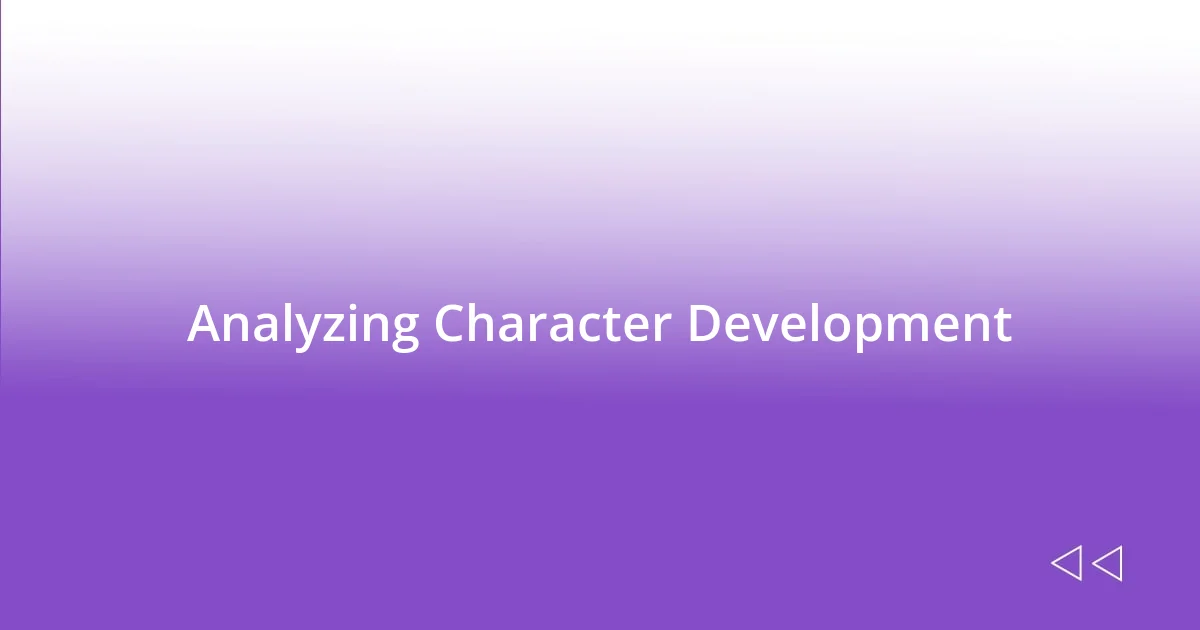
Analyzing Character Development
Character development is one of the most compelling elements of literary fiction. When I read, I always look for the characters’ growth, wondering how their experiences shape them over time. For instance, in “A Little Life” by Hanya Yanagihara, I was captivated by Jude St. Francis and his transformative journey through trauma and friendship. It was heartbreaking and beautifully written, which really drew me into his struggle. How does a character’s past dictate their future actions? This question continually resonates with me as I explore richer narratives.
Throughout my readings, I’ve noticed that the best characters often have flaws that make them relatable. One of my most memorable experiences was reading “Pride and Prejudice.” Elizabeth Bennet’s initial judgments about Darcy enhanced my appreciation for her character arc. Her growth, as she learned to see beyond first impressions, felt like a gentle reminder of my own tendencies to hold onto preconceived notions. Have you encountered characters whose flaws mirror your own? Those moments create a visceral connection that deepens my engagement with the story.
To truly appreciate character development, I find it helpful to analyze the relationships dynamics within the book. The interactions between characters often reveal their innermost fears and desires. While reading “Where the Crawdads Sing,” I was particularly struck by the evolving relationship between Kya and Tate. Watching Kya’s vulnerability unfold in the face of love was both poignant and enlightening. It’s fascinating to consider how these interactions not only propel the plot but also highlight the complexities of human experience. Each time I revisit a novel, I uncover different layers in these relationships, which never fails to surprise me. Does that not make the experience of reading a continuous journey of discovery?
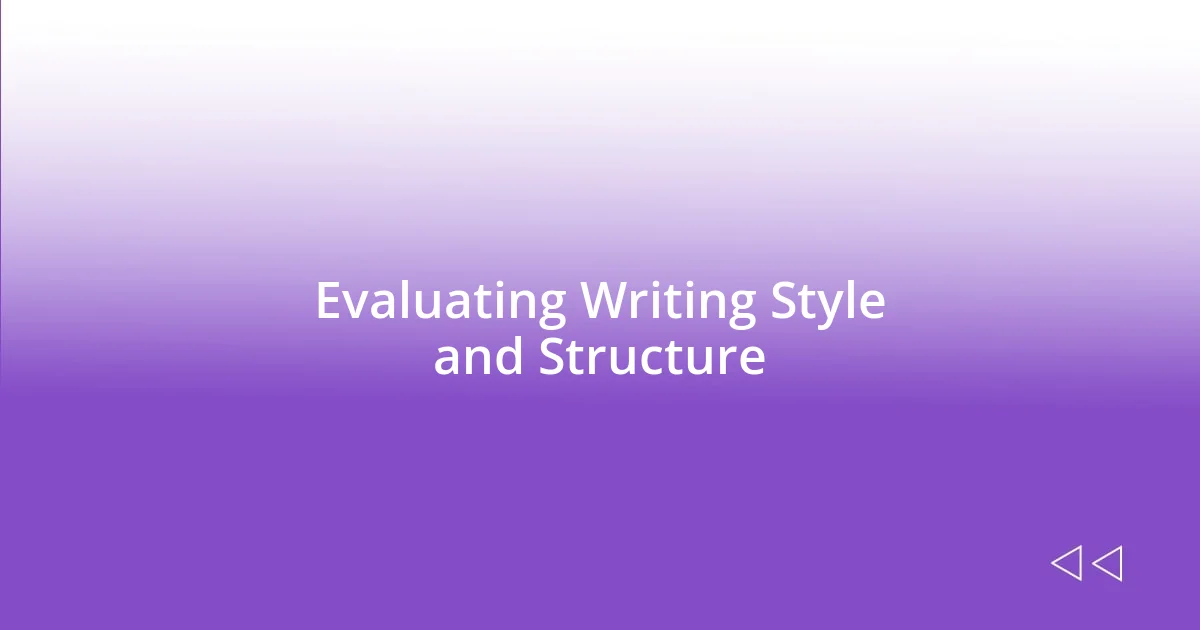
Evaluating Writing Style and Structure
Evaluating writing style and structure is essential for fully grasping a narrative. When I dive into a book, the author’s voice often creates a unique rhythm that either captivates me or leaves me feeling disconnected. For example, in “The Goldfinch” by Donna Tartt, her lyrical prose drew me in, wrapping me in the world she crafted. Do you ever find that sometimes the style of writing speaks to you more than the plot itself?
I also pay close attention to how the structure of a story influences my reading experience. Non-linear narratives, like in “A Visit from the Goon Squad” by Jennifer Egan, can disorient at first, but they often lead to surprising revelations. I remember struggling a bit with the jumping timelines, yet once I grasped the connections, it felt like piecing together a puzzle. Has a book’s structure ever challenged your understanding of the story?
Furthermore, I believe that elements such as dialogue and syntax play significant roles in how I engage with a text. I often find myself captivated by sharp, witty dialogue that reveals character depth, like in “The Brief Wondrous Life of Oscar Wao” by Junot Díaz. His unique blend of slang and formal English creates a vibrant tapestry that immerses me in the culture and context. Isn’t it incredible how word choice can evoke not just images, but emotions and connections that linger long after the last page?
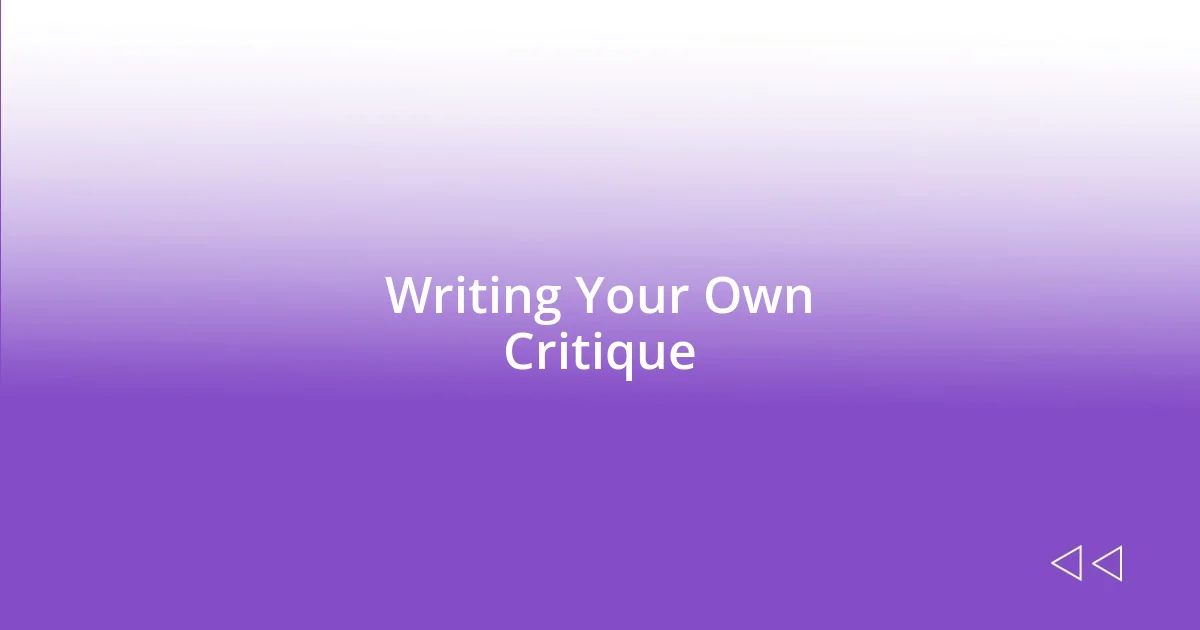
Writing Your Own Critique
Writing my own critique is a profoundly personal yet structured exercise. I usually start by gathering all my thoughts and feelings about the book, allowing them to flow onto the page without judgment. It’s akin to freewriting; both exhilarating and chaotic. There’s a thrill in pinpointing the elements that resonated with me, like the emotional weight of a scene or the nuances in character relationships. Have you ever experienced a moment where a passage made you pause, reflecting on your own life? That’s often where my critiques begin.
Once I’ve captured my initial impressions, I dive deeper into the narrative techniques employed by the author. I find it helpful to analyze specific quotes or scenes that encapsulate my reactions. For example, after reading “Beloved” by Toni Morrison, I was deeply moved by the haunting language that Morrison uses to explore memory and trauma. Selecting choice phrases not only clarifies my perspective but gives the critique a grounding in the text. What phrases or moments have stuck with you, and how do they shape your understanding of the story?
Finally, I aim to connect my analyses to broader themes, considering how they relate to human experience. Writing a critique is as much about personal reflection as it is about analysis. When I critiqued “The Night Circus” by Erin Morgenstern, I realized the beauty of transformation echoed my own life changes. This layer of personal experience adds depth, making the critique not merely an assessment but a dialogue between myself and the text. Doesn’t that create a richer narrative in your writing, transforming it from a simple summary into an exploratory journey?
